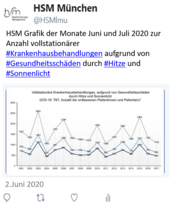Impact of geriatric comorbidity and polypharmacy on cholinesterase inhibitors prescribing in dementia.
| Autoren/Herausgeber: |
Hoffmann, F. van den Bussche, H. Wiese, B. Schön, G. Koller, D. Eisele, M. Glaeske, G. Scherer, M. Kaduszkiewicz, H. |
|---|---|
| Erschienen: | 2011 |
| Publikationsart: | Articles in Refereed Journals (International) |
| ISBN/ISSN: | 1471-244X |
| erschienen in: | BMC Psychiatry |
| Weitere Quellenangabe: | Volume 11(1), Page 190 |
Abstract
Background
Although most guidelines recommend the use of cholinesterase inhibitors (ChEIs) for mild to moderate Alzheimer's Disease, only a small proportion of affected patients receive these drugs. We aimed to study if geriatric comorbidity and polypharmacy influence the prescription of ChEIs in patients with dementia in Germany.
Methods
We used claims data of 1,848 incident patients with dementia aged 65 years and older. Inclusion criteria were first outpatient diagnoses for dementia in at least three of four consecutive quarters (incidence year). Our dependent variable was the prescription of at least one ChEI in the incidence year. Main independent variables were polypharmacy (defined as the number of prescribed medications categorized into quartiles) and measures of geriatric comorbidity (levels of care dependency and 14 symptom complexes characterizing geriatric patients). Data were analyzed by multivariate logistic regression.
Results
On average, patients were 78.7 years old (47.6% female) and received 9.7 different medications (interquartile range: 6-13). 44.4% were assigned to one of three care levels and virtually all patients (92.0%) had at least one symptom complex characterizing geriatric patients. 13.0% received at least one ChEI within the incidence year. Patients not assigned to the highest care level were more likely to receive a prescription (e.g., no level of care dependency vs. level 3: adjusted Odds Ratio [OR]: 5.35; 95% CI: 1.61-17.81). The chance decreased with increasing numbers of symptoms characterizing geriatric patients (e.g., 0 vs. 5+ geriatric complexes: OR: 4.23; 95% CI: 2.06-8.69). The overall number of prescribed medications had no influence on ChEI prescription and a significant effect of age could only be found in the univariate analysis. Living in a rural compared to an urban environment and contacts to neurologists or psychiatrists were associated with a significant increase in the likelihood of receiving ChEIs in the multivariate analysis.
Conclusions
It seems that not age as such but the overall clinical condition of a patient including care dependency and geriatric comorbidities influences the process of decision making on prescription of ChEIs.





